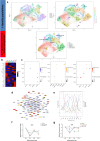Activation of AMPK promotes cardiac differentiation by stimulating the autophagy pathway
- PMID: 37040028
- PMCID: PMC10409960
- DOI: 10.1007/s12079-023-00744-z
Activation of AMPK promotes cardiac differentiation by stimulating the autophagy pathway
Abstract
Autophagy, a critical catabolic process for cell survival against different types of stress, has a role in the differentiation of various cells, such as cardiomyocytes. Adenosine 5'-monophosphate (AMP)-activated protein kinase (AMPK) is an energy-sensing protein kinase involved in the regulation of autophagy. In addition to its direct role in regulating autophagy, AMPK can also influence other cellular processes by regulating mitochondrial function, posttranslational acetylation, cardiomyocyte metabolism, mitochondrial autophagy, endoplasmic reticulum stress, and apoptosis. As AMPK is involved in the control of various cellular processes, it can influence the health and survival of cardiomyocytes. This study investigated the effects of an AMPK inducer (Metformin) and an autophagy inhibitor (Hydroxychloroquine) on the differentiation of human pluripotent stem cell-derived cardiomyocytes (hPSC-CMs). The results showed that autophagy was upregulated during cardiac differentiation. Furthermore, AMPK activation increased the expression of CM-specific markers in hPSC-CMs. Additionally, autophagy inhibition impaired cardiomyocyte differentiation by targeting autophagosome-lysosome fusion. These results indicate the significance of autophagy in cardiomyocyte differentiation. In conclusion, AMPK might be a promising target for the regulation of cardiomyocyte generation by in vitro differentiation of pluripotent stem cells.
Keywords: AMPK; Autophagy; Cardiomyocyte differentiation; Hydroxychloroquine; Metformin.
© 2023. The International CCN Society.
Conflict of interest statement
The authors declare that there is no conflict of interest.
Figures




Similar articles
-
Inhibition of PRKAA/AMPK (Ser485/491) phosphorylation by crizotinib induces cardiotoxicity via perturbing autophagosome-lysosome fusion.Autophagy. 2024 Feb;20(2):416-436. doi: 10.1080/15548627.2023.2259216. Epub 2024 Jan 25. Autophagy. 2024. PMID: 37733896 Free PMC article.
-
Activation of AMPK Promotes Maturation of Cardiomyocytes Derived From Human Induced Pluripotent Stem Cells.Front Cell Dev Biol. 2021 Mar 9;9:644667. doi: 10.3389/fcell.2021.644667. eCollection 2021. Front Cell Dev Biol. 2021. PMID: 33768096 Free PMC article.
-
The role of AMPK in cardiomyocyte health and survival.Biochim Biophys Acta. 2016 Dec;1862(12):2199-2210. doi: 10.1016/j.bbadis.2016.07.001. Epub 2016 Jul 10. Biochim Biophys Acta. 2016. PMID: 27412473 Review.
-
Doxorubicin downregulates autophagy to promote apoptosis-induced dilated cardiomyopathy via regulating the AMPK/mTOR pathway.Biomed Pharmacother. 2023 Jun;162:114691. doi: 10.1016/j.biopha.2023.114691. Epub 2023 Apr 14. Biomed Pharmacother. 2023. PMID: 37060659
-
Implication and Regulation of AMPK during Physiological and Pathological Myeloid Differentiation.Int J Mol Sci. 2018 Sep 30;19(10):2991. doi: 10.3390/ijms19102991. Int J Mol Sci. 2018. PMID: 30274374 Free PMC article. Review.
Cited by
-
Revisiting the Role of Autophagy in Cardiac Differentiation: A Comprehensive Review of Interplay with Other Signaling Pathways.Genes (Basel). 2023 Jun 24;14(7):1328. doi: 10.3390/genes14071328. Genes (Basel). 2023. PMID: 37510233 Free PMC article. Review.
-
Integrated multi-omics analysis identifies features that predict human pluripotent stem cell-derived progenitor differentiation to cardiomyocytes.J Mol Cell Cardiol. 2024 Nov;196:52-70. doi: 10.1016/j.yjmcc.2024.08.007. Epub 2024 Sep 1. J Mol Cell Cardiol. 2024. PMID: 39222876
-
Regulation of autophagy by the PI3K-AKT pathway in Astragalus membranaceus -Cornus officinalis to ameliorate diabetic nephropathy.Front Pharmacol. 2025 May 13;16:1505637. doi: 10.3389/fphar.2025.1505637. eCollection 2025. Front Pharmacol. 2025. PMID: 40432887 Free PMC article.
-
Crosstalk among Reactive Oxygen Species, Autophagy and Metabolism in Myocardial Ischemia and Reperfusion Stages.Aging Dis. 2024 May 7;15(3):1075-1107. doi: 10.14336/AD.2023.0823-4. Aging Dis. 2024. PMID: 37728583 Free PMC article. Review.
References
Grants and funding
LinkOut - more resources
Full Text Sources
Research Materials

